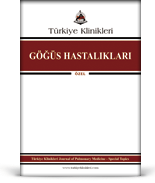Reaktif oksijen türleri (ROT), reaktif nitrojen türleri (RNT) ve son zamanlarda tanımlanan reaktif sülfür türleri (RST) gibi serbest radikal oksidanlar veya radikal olmayan oksidanlar, fagositlerin yanı sıra polimorfonükleer, alveolar, bronşiyal ve endotelyal hücrelerde endojen olarak ve sigara dumanı, hava kirliliği, mineral tozu, ozon, radyasyon gibi ekzojen kaynaklardan çeşitli metabolik süreçlerle üretilmektedir. Normal hücre fonksiyonlarının devam etmesi için belirli düzeylerde ROT/RNT gerekli olmakla birlikte, normal fizyolojik koşullarda organizmada oksidan ve antioksidan moleküller denge hâlindedir. Bu denge sağlandığı sürece organizma, oksidan moleküllerden zarar görmez. Bununla birlikte, aşırı ROT/RNT üretimi ve/veya yetersiz antioksidan sistem etkinliği, genellikle oksidatif strese (OS) yol açar.
Yüzden fazla hastalık, serbest radikaller ile ilişkilendirilmektedir. Bu hastalıklar içinde oksidatif stresten en çok etkilenen organ ise akciğerdir.
Oksidatif stres lipidler, proteinler, karbonhidratlar ve deoksiribonükleik asit (DNA) dahil olmak üzere membran lipidleri ve ribonükleik asit (RNA) üzerinde oksidatif hasara yol açabilmektedir. Oksidatif hasar, membran lipitlerindeki çoklu doymamış yağ asitleri gibi organik biyomoleküllerde değişime, proteinlerin, DNA ve RNA'nın oksidasyonuna, mitokondriyal depolarizasyona ve apoptoz gibi önemli zararlara yol açabilmektedir. Hücrenin yapısal bileşenlerinde (biyomoleküllerde) oluşan bu değişimler . dokusal hasarla sonuçlanabilir; ayrıca kronik rinosinüzit, kronik obstrüktif akciğer hastalığı (KOAH), idiyopatik pulmoner fibrozis (İPF), otonom nöropati, pnömokonyozlar gibi kronik patolojik süreçlerin yanı sıra akut solunum sıkıntısı sendromu (ARDS), astım, pnömoni, hiperkoagulabilite ve akciğer kanseri gibi bir dizi solunum sistemi hastalığının patogenezi ve prognozunda birincil veya önemli rol oynayabilir. Klinikopatolojik süreçlerde oksidatif stres, antioksidan tedavi dışı bir kısım tedavi protokollerinin yeterince etkili olamaması veya etkisiz kalmasında da önemli pay sahibi olabilmektedir.
Antioksidanlar, oksidan artışının neden olduğu doku hasarının önlenmesinde, mevcut oksidatif hasarın onarılmasında önemlidirler ve tedavi edici role sahiptirler. Oksidatif stres veya endojen antioksidanların yetersiz kalması durumunda, eksojen antioksidan desteği gerekli olabilir. Ancak burada tedavi tercihi konusunda iki sorun göze çarpmaktadır; bunlardan biri antioksidan tedavinin etkinliğinin ve sonuçlarının erken ve hızlı gözlenememesi; bazen aylarca uzayabilen bir tedavi süresine ihtiyaç duyulması, diğeri ise son yıllarda tıpkı kişiye özel (akıllı) ajanların etki mekanizmasına benzer şekilde farklı hastalıklar için oksidan ve antioksidan sistemin farklı patogenetik ve moleküler mekanizmalar üzerinden etki göstermesidir. Bu durumda, tedavinin başarısı için, antioksidan tedavi seçeneklerinin de hastalık bazında farklılık gösterebileceği göz önünde bulundurulmalı ve dikkate alınmalıdır.
Özenle hazırlanmış her bölümün analitik bir yaklaşımla okunmasının, okuyucunun kendi ilgi alanlarına yönelik medikal, akademik ve bilimsel anlamda bakış açılarına önemli değerler katacağına inanmaktayım.
Prof. Dr. Tuncer TUĞ
Editör
Reactive oxygen species (ROS), reactive nitrogen species (RNT), and the recently identified reactive sulfur species (RST), such as free radical oxidants or non-radical oxidants, are produced endogenously in polymorphonuclear, alveolar, bronchial, and endothelial cells as well as in phagocytes. They are also produced through various metabolic processes from exogenous sources such as cigarette smoke, air pollution, mineral dust, ozone, and radiation. Although ROS/RNT at certain levels is required for normal cell functions to continue, oxidant and antioxidant molecules are in balance in the organism under normal physiological conditions. As long as this balance is maintained, oxidant molecules will not harm the organism. However, excessive ROS/RNT production and inadequate antioxidant system activity often lead to oxidative stress (OS).
More than a hundred diseases are associated with free radicals. Among these diseases, the organ most affected by oxidative stress is the lung.
Oxidative stress can cause oxidative damage to membrane lipids and ribonucleic acid (RNA), including lipids, proteins, carbohydrates, and deoxyribonucleic acid (DNA). Oxidative damage can also cause significant damage, such as changes in organic biomolecules such as polyunsaturated fatty acids in membrane lipids, oxidation of proteins, DNA and RNA, mitochondrial depolarization, and apoptosis. These changes in the structural components (biomolecules) of the cell can result in tissue damage and so on, in pathogenesis and prognosis of chronic pathological processes such as chronic rhinosinusitis, chronic obstructive pulmonary disease (COPD), idiopathic pulmonary fibrosis (IPF), autonomic neuropathy, pneumoconiosis in addition to many respiratory system diseases such as acute respiratory distress syndrome (ARDS), asthma, pneumonia, hypercoagulability and lung cancer may also play a primary or important role. In clinicopathological processes, oxidative stress may also play a significant role in the failure or ineffectiveness of some treatment protocols other than antioxidant therapy.
Antioxidants are essential in preventing tissue damage caused by oxidant increase and in repairing existing oxidative damage and have a therapeutic role. Exogenous antioxidant supplementation may be necessary in case of oxidative stress or insufficiency of endogenous antioxidants. However, two problems stand out here regarding treatment choice; one of these is the failure to observe the effectiveness and results of antioxidant treatment early and quickly; it is needed for a treatment period that can sometimes extend for months; the other is that in recent years, the oxidant and antioxidant system acts through different pathogenetic and molecular mechanisms for various diseases, similar to the mechanism of action of personalized (intelligent) agents. In this case, for the success of the treatment, it should be considered that antioxidant treatment options may differ depending on the disease.
Reading each carefully prepared chapter with an analytical approach will add significant value to the reader's medical, academic, and scientific perspectives on their areas of interest.
Prof. Dr. Tuncer TUĞ
Editor







.: İşlem Listesi